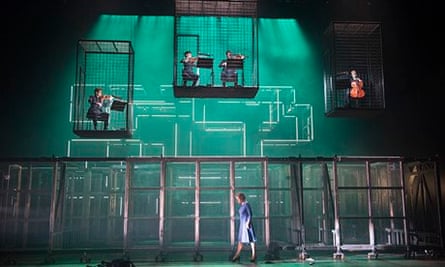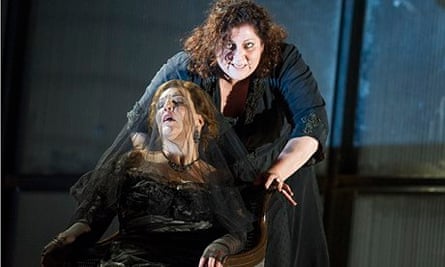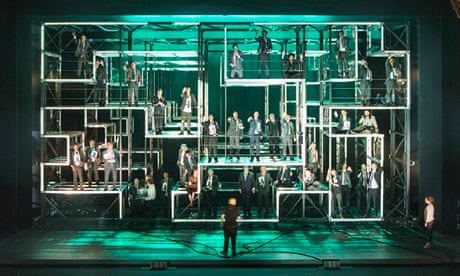Kafka's The Trial, glass and steel tower blocks, a walk-on part for Casanova and a hang-on part for an aerial string quartet: these are the ingredients that Calixto Bieito has conjured for his new Fidelio for English National Opera. It sounds grim. No doubt the boos were inevitable. If you start the evening with an actor reading a Borges sonnet – think infinite labyrinths and universal darkness – there will be many Fidelio fans in the audience who already want to go home.
Compared to Edinburgh's lost-in-space fiasco staged last month, nonetheless, this production managed to have mixed virtues and some powerful moments. Musical standards were exciting. Emma Bell's serene, ardent Leonore and Stuart Skelton's jumbo, half-mad Florestan, sung with absolute beauty and control, led the strong cast. Edward Gardner, who gets better and better (I've said it before), approached the score with generosity, fervour and vigour.
After the poem prologue, the ENO orchestra, agile and fresh, played the overture Leonore No 3, usually reserved for concert use. The evening pounded into life, the opera's journey to freedom encapsulated in those 15 minutes of music. Rebecca Ringst's set, a giant maze of transparent, neon-lit boxes that tilted and reshaped itself cunningly, trapped the action but looked handsome.
We had plenty of time to contemplate it. I tried not to be irritated by the tubular lighting flashing on and off according to Gardner's beat, though the effort was considerable. Up until the interval it seemed enough to go along with Bieito's idea that each character is suffering his or her own kind of loss and imprisonment. This justified the abstract nature of the storytelling and the excision of the original spoken dialogue. The prisoners' chorus, fabulously and urgently delivered by the ENO chorus, was staged to remind us, tenderly, that these were people, not merely faces of numbers.
In the second half, all freewheeled downhill. After Leonore and Florestan's duet, the excellent Heath Quartet were lowered from the flies in cages, playing the beginning of the third movement of Beethoven's Op 132 – written long after Fidelio and, inserted here, instantly confusing the pace, action, sense and coherence of the opera itself. To find oneself longing for such a sublime piece of music to hurry up and shut up was not a good feeling.

The slow lyricism of the quartet contrasted totally with the maverick symphonic interplay and paradoxical brightness of the opera. If that was Bieito's point, it escaped me. Then as the offstage trumpet sounded and freedom and justice were in sight, all kinds of interventions wrecked the moment dramatically, though, it must be said, never musically. Don Fernando the minister, there to bring enlightenment, shimmied on dressed in velvet frock coat and tricorn as a camp 18th-century Casanova. Redemption was reduced to trivia and you could sense the audience bristling. Other interventions – the shooting and miraculous recovery of Florestan was one – muddied the pretty straightforward story of a wife who risks her own life to rescue her incarcerated husband.
But rise above these theatrical solecisms and go, if only to honour the wonderful musicians: Gardner, the orchestra, the chorus, and other soloists – including James Creswell, particularly sympathetic as Rocco the jailer, Sarah Tynan (Marzelline) and Adrian Dwyer (Jaquino) – made this an evening to remember, even if the rest is best forgotten.
Ever alert to the shock of the new, in 1910 the Observer reported that rehearsals for Richard Strauss's Elektra at Covent Garden were of "unprecedented length and severity". Crowds scrapped viciously for tickets, requiring the control of heavies. No bouncers were in sight last week at the Royal Opera's second revival of Charles Edwards's production, which he also designed. Judging by the spare seats, no one was fighting for tickets either. They should be.
This is the house of Atreus – that nice family who had fratricide, matricide and any other cide besides in their DNA – as refined by the subtle imagination of Hugo von Hofmannshthal, whose libretto added layers of psychology and richness to Sophocles's tragedy and gave Strauss one of his best texts. In this 2003 staging, the action takes place in a mixed landscape of Weimar with ancient marble frieze and modern, tilted Perspex wall: three distinct visual styles which unite convincingly to make the revenge-narrative plain.

For more than half the opera, until the breath-drawing pause in the action when Elektra's brother Orest arrives, only women's voices are heard: nine soloists belting out their venom with fish-wife hysteria. The cast on Monday's opening night was outstanding. There was no weak link. As so often in Strauss, domesticity and grand tragedy grate against each other, chisel on rock, vividly represented in the deafening, dissonant abrasions of the music.
Andris Nelsons, conducting, achieved brilliance and transparency in this extraordinary score. Instead of sounding merely noisy or smudgy, all the intricate details were laid bare. The Royal Opera orchestra was on coruscating form: lyrical in moments of unexpected compassion, raw when the scrapings and grumblings sound as if the very foundations of this sickly dynasty are collapsing, urged on by the whispers and scurries of moths, rats or scorpions. How many film composers have stolen from Strauss? Imagine the shower scene in Psycho – though the comparison is hardly original – running on for nearly two hours and you begin to feel the strangling impact of Elektra.
The international cast exhausted every vocal possibility, ranging from scream to caress to rebuke. Iain Paterson was a brutal and enigmatic Orest, with John Daszak sly and insinuating as Aegisth. Adrianne Pieczonka shone, enthralling and sweetly beguiling, as the home-loving Chrysothemis. Michaela Schuster's Klytemnestra turned guilt and depravity into a high art.
The night belonged to Christine Goerke in the title role. Her lament for her murdered father, Agamemnon, was agonising, her anger white hot, her torment exquisite, her dance at once clumsy and febrile. Goerke bestrode this operatic monster with immaculate control. It's hard to imagine better. Throughout, the stage oozed and seeped horribly, though as usual this opera can never have enough blood.

Comments (…)
Sign in or create your Guardian account to join the discussion